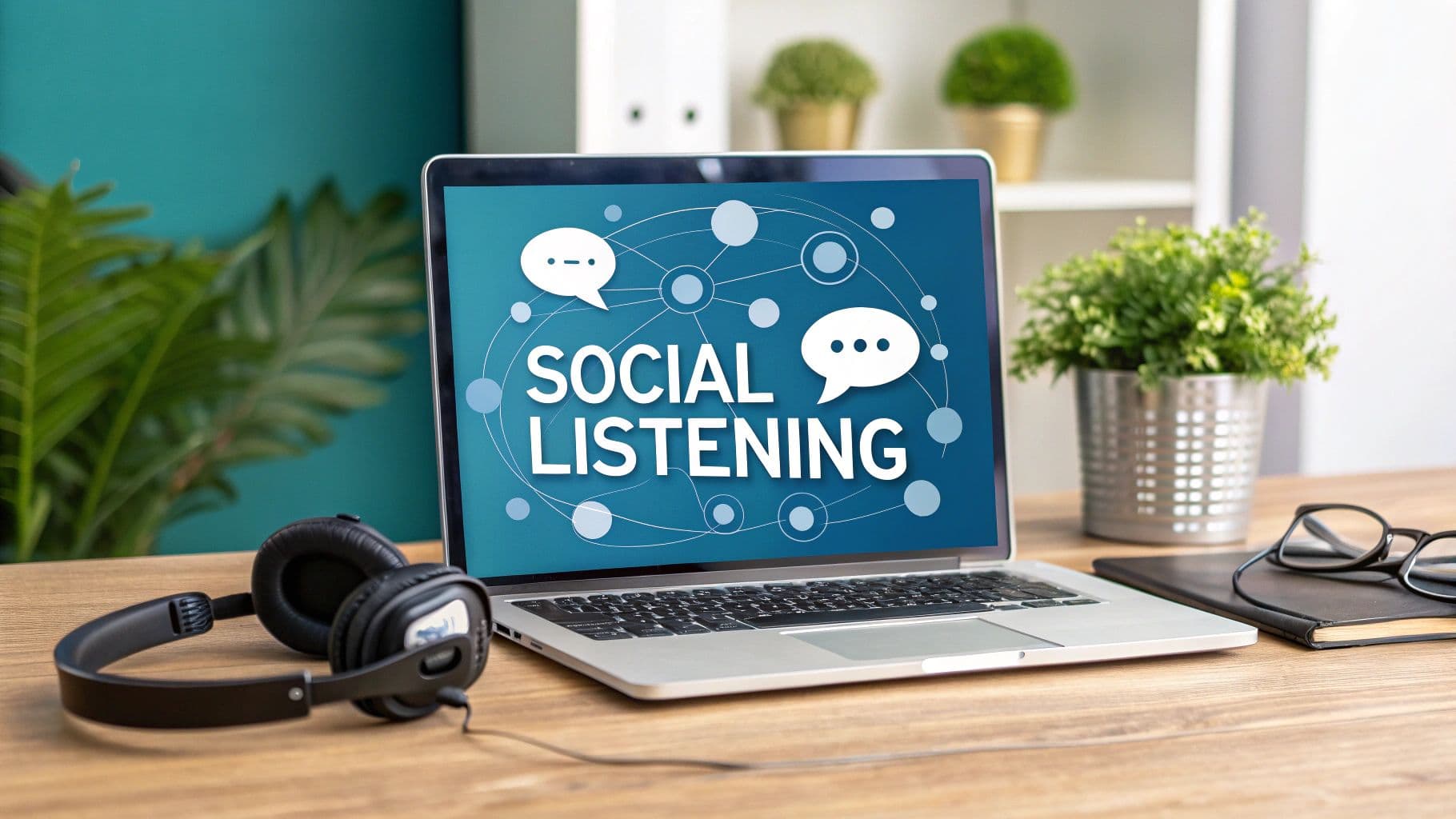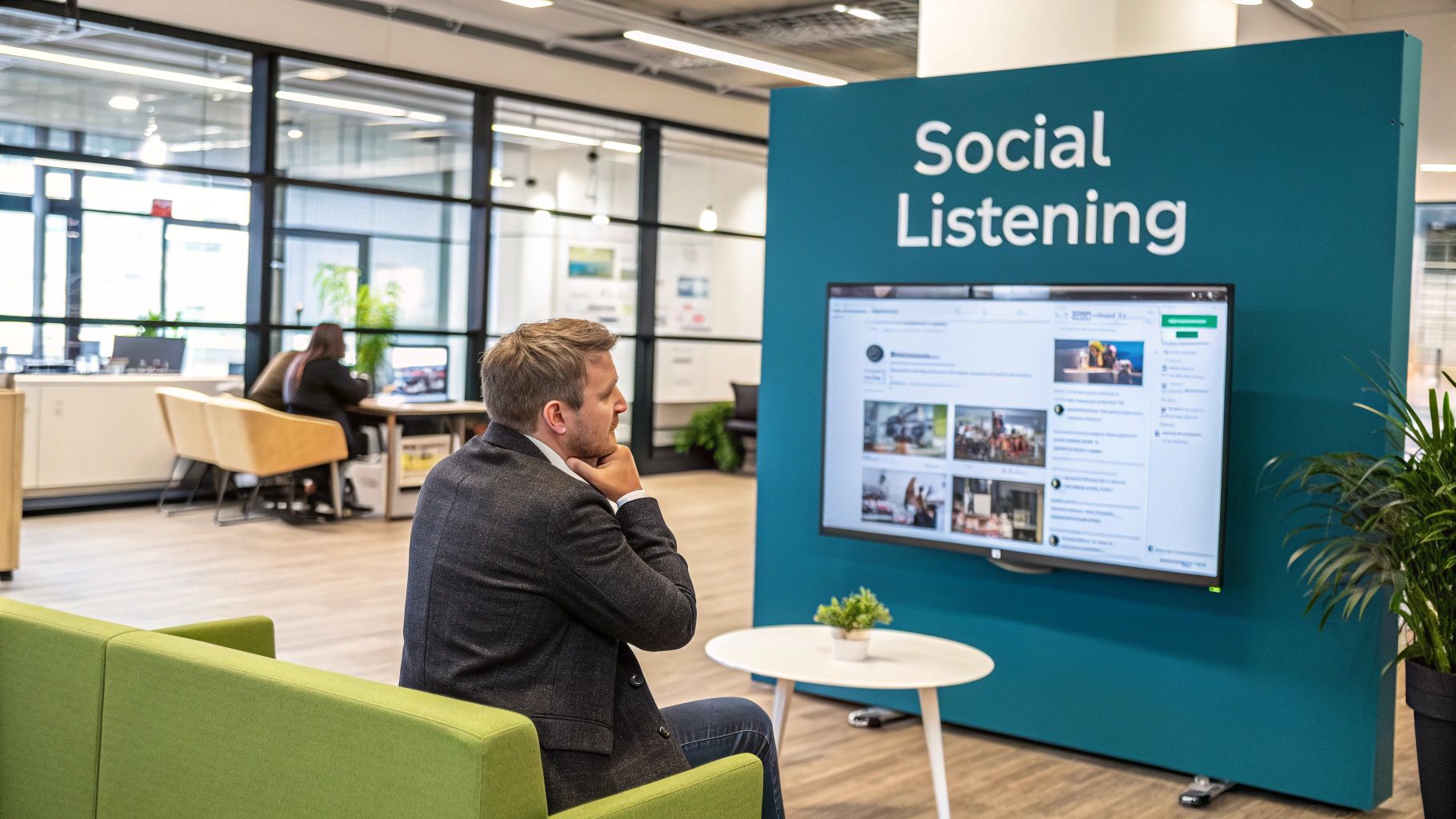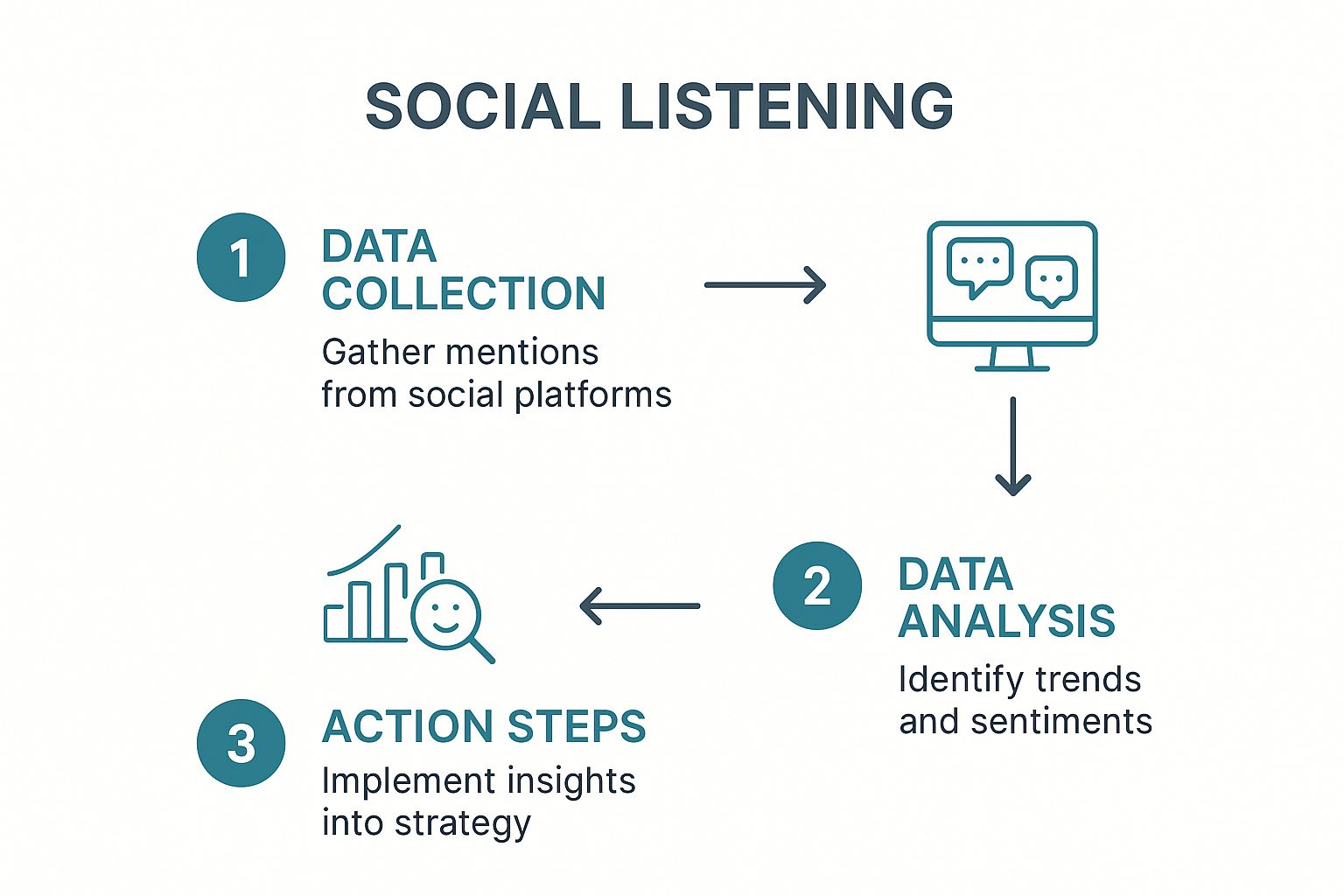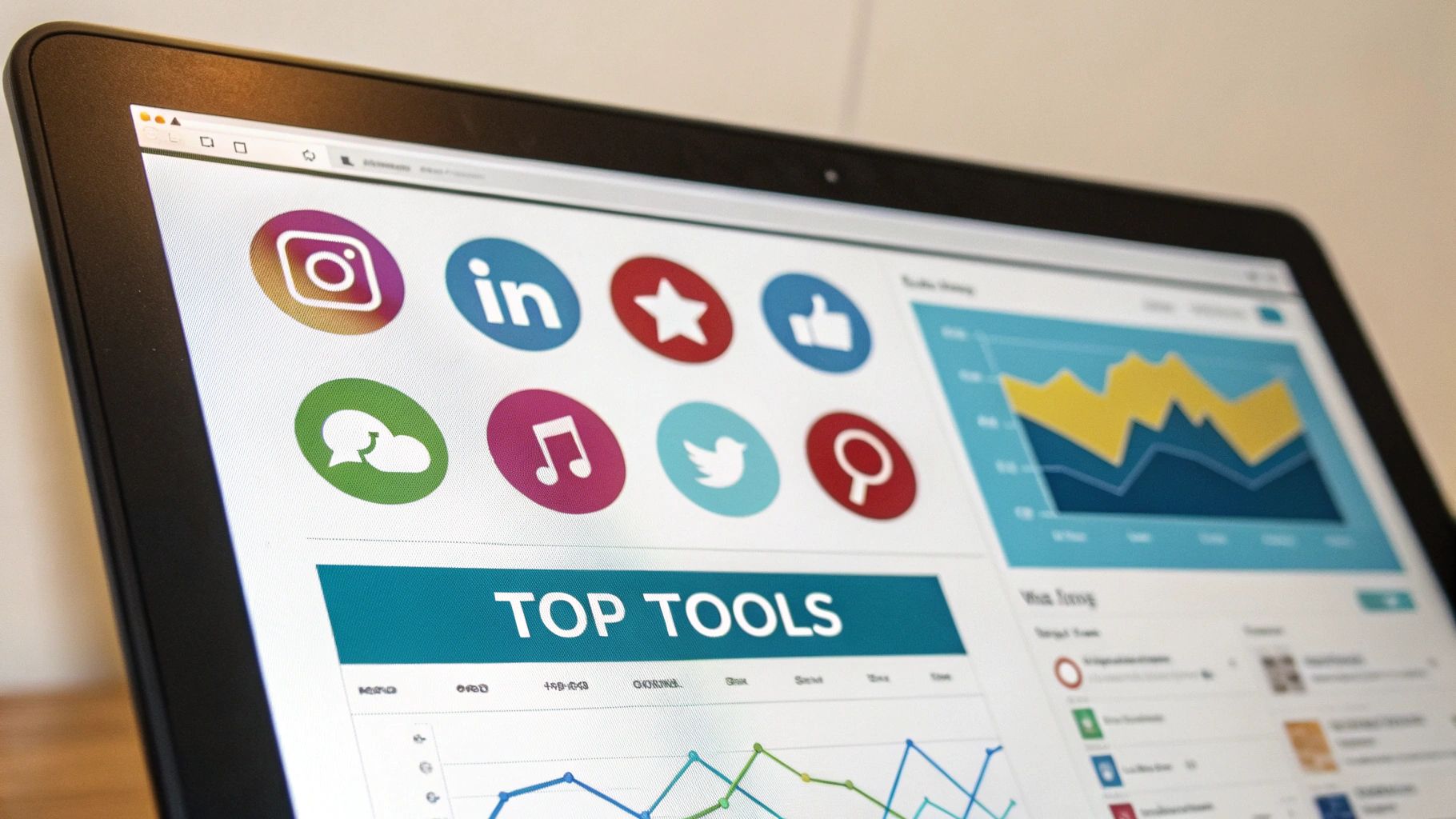
Let's cut the jargon. As a founder, you're constantly looking for an edge. Social listening is it. It’s not about vanity metrics; it’s about systematically finding people online who have a problem your business can solve.
Forget just tracking brand mentions. True social listening is about analyzing the entire online conversation around your industry, your competitors, and the specific pain points you address. The magic isn't in hearing the chatter; it's in using that intel to make faster, smarter decisions that lead directly to growth. It's moving from reacting to mentions to proactively finding opportunities.
What Social Listening Looks Like in the Real World

Forget the textbook definitions. As a founder, think of social listening as your secret weapon—it's your ability to overhear every important conversation happening online, especially when your brand isn't tagged.
This is the key difference between social listening and its more basic cousin, social monitoring. They sound similar, but their purpose is worlds apart.
Social Listening vs Social Monitoring
Many people use these terms interchangeably. That's a mistake. Monitoring is tactical and reactive. Listening is strategic and proactive. Understanding this is the first step to unlocking its real power.
| Aspect | Social Monitoring (Reactive) | Social Listening (Proactive) |
|---|---|---|
| Focus | Individual mentions, comments, and direct tags. | Broader conversations, trends, and sentiment. |
| Scope | What happened? (e.g., "Someone mentioned us.") | Why is it happening? (e.g., "Why are people talking about this feature?") |
| Goal | Respond to direct customer interactions. | Inform overall business strategy and identify opportunities. |
| Timeframe | Short-term, immediate responses. | Long-term analysis of data over time. |
In short, monitoring is about putting out fires. Listening is about understanding the climate so you can prevent fires from starting in the first place—and find new places to build.
From Online Noise to Real-World Opportunity
At BillyBuzz, we don’t just track our brand name. We actively listen for problems our software can solve. This simple shift turns random online noise into a predictable source of new customers, reputation management, and product development insights.
It's all about finding the signal in the noise.
For example, we set up alerts to find people who are publicly frustrated with a competitor or are asking for a solution that we offer. This lets us jump into the conversation at the perfect moment, armed with genuine context and a helpful solution.
This strategic approach is catching on. The global social listening market was valued at around USD 9.2 billion in 2024 and is expected to blow past USD 20 billion by 2030. Founders are waking up to the fact that ignoring these conversations means leaving money and opportunities on the table. You can read more about this explosive growth over at Grandview Research.
The Bottom Line for Founders
For a startup founder, the goal of social listening is brutally simple: growth. It’s about getting direct answers to the critical questions that impact your business every single day:
- Lead Generation: Where are my ideal customers asking for a solution like ours right now?
- Competitive Intelligence: What are my competitors' customers complaining about that I can solve?
- Brand Health: How do people truly feel about my brand when they think we aren't looking?
- Product Feedback: What missing features are people practically begging for in my industry?
By systematically tracking and analyzing these discussions, you stop guessing what your market wants and start knowing what they need. You can explore more of these applications in our other articles about social listening.
How the Technology Actually Works
So, how does social listening sift through the endless chatter of the internet to pull out a single, golden insight? It's a clever three-step process. Let's walk through it from a founder's perspective, not a data scientist's.
This workflow is the key to turning raw, messy online conversations into clear, strategic actions.

Each step builds on the one before it, methodically transforming chaotic data into a real asset for growing your business.
Step 1: Data Collection
Everything starts by casting a wide—but very specific—net. Social listening tools constantly scan public data from places like Reddit, X (formerly Twitter), blogs, and forums. Picture it as a team of digital scouts searching 24/7 for the exact keywords you told them to find.
Here at BillyBuzz, we do more than just track our brand name. We use Boolean logic to hunt for conversations that signal real intent. Here's an actual alert rule we use:
("social listening" OR "brand monitoring") AND ("tool" OR "software") AND ("alternative" OR "recommendation" OR "frustrated with")
This command tells our system to find posts where someone is not just talking about our industry, but is also actively looking for a new solution. That’s how we find people practically raising their hands to say they're ready for a change.
Step 2: Data Processing and Analysis
Once the data is pulled in, the real work begins. Raw mentions are a jumbled mess, full of spam. This is where AI shines, cleaning up and making sense of everything. It handles two crucial jobs:
- Noise Filtering: The system automatically tosses out spam, duplicates, and irrelevant mentions, leaving you with a clean, relevant feed.
- Sentiment Analysis: Next, AI algorithms read the language and context of each mention to figure out if the feeling behind it is positive, negative, or neutral. This is how you can spot a looming PR crisis or get a quick read on brand health.
This stage is about turning a firehose of raw mentions into something you can understand at a glance. It answers the fundamental question: "What's the general vibe out there?"
Step 3: Data Visualization
Finally, all that processed data has to be presented in a way that’s actually useful. A massive spreadsheet is the last thing a busy founder needs. A good social listening tool translates everything into an intuitive dashboard. In fact, a robust social media analytics dashboard is essential for seeing the story the data is telling.
This is where you spot trends, see how your share of voice stacks up against competitors, and identify key themes. Think of it as your command center, helping you connect what people are saying online with what you need to do next.
Inside the BillyBuzz Listening Playbook
Theory is one thing; execution is everything. So, here's our founder-to-founder promise: we’re opening our playbook and sharing the exact blueprint we use to turn online chats into paying customers. This isn't high-level fluff. It’s the tactical guide we live by.
Our entire strategy is built on one idea: find people who have a problem we can solve, right at the moment they're looking for an answer. We don't wait for them to stumble upon us; we go where the conversation is already happening.

This proactive mindset means we focus our energy where our ideal customers—fellow founders and marketers—are hanging out. For us, that's Reddit. We get super specific, setting up alerts for a handful of high-value subreddits where real business problems are discussed every day.
Our High-Signal Subreddit Targets
We don't try to boil the ocean. That's a waste of time. Instead, we zero in on a few key communities where our potential customers talk shop, share struggles, and ask for advice.
Here are the subreddits we have filtered inside BillyBuzz:
- r/saas: Ground zero for SaaS founders. They’re talking growth, churn, and tools they love (and hate).
- r/startups: A goldmine for early-stage founders figuring out how to land their first users.
- r/marketing: We monitor this for chatter around lead generation and brand monitoring where our tool is a natural fit.
Concentrating on specific channels is our most important filter. It cuts the noise and ensures our team only gets alerts worth engaging with.
Crafting Keywords That Convert
Our keyword strategy is the engine behind this. We break keywords into three distinct buckets, each with a specific job. This tiered approach helps us catch everything from direct competitor call-outs to broader, problem-focused discussions.
Here’s a look at how we structure our keyword monitoring inside BillyBuzz.
BillyBuzz Keyword Monitoring Setup
An example of our tiered keyword strategy for capturing brand, competitor, and problem-aware conversations.
| Category | Actual Keywords We Use | Objective |
|---|---|---|
| Brand & Competitor | "Brandwatch alternative," "Meltwater is too expensive," "frustrated with Sprinklr," "better than Brand24" | Jump in when people are actively unhappy with a competitor and looking for a change. |
| Problem-Aware | "how to find customers on Reddit," "track brand mentions," "social listening for startups" | Find potential users who know they have a problem but might not know a solution like ours exists. |
| Use Case-Based | "generate leads from Reddit," "find negative feedback," "monitor my industry," "track competitors" | Target folks trying to achieve a specific goal that our tool was built to handle. |
This multi-layered approach ensures we engage with people at every stage of their buying journey.
Founder-to-Founder Tip: The best opportunities often come from those problem-aware keywords. Someone complaining about a competitor is a warm lead. But someone describing a problem you can solve? That's your chance to become their hero.
Our Go-To Response Template
Once we spot a relevant conversation, we don't just drop a link. That’s a fast track to getting ignored. Our goal is to be genuinely helpful first.
Here’s a slightly modified version of the template our team uses.
The BillyBuzz Engagement Template:
"Hey [Username], saw you were looking for ways to [mention their specific goal, e.g., 'find your first users on Reddit']. It can definitely be a challenge to cut through the noise.
One thing that helped us was focusing on [offer a piece of genuine advice, e.g., 'problem-based keywords in niche subreddits instead of broad ones']. This usually surfaces conversations with higher intent.
Full transparency, we built a tool called BillyBuzz to automate this process because we were spending hours doing it manually. It sends us alerts for these kinds of conversations. No pressure to check it out, but it might be useful for what you're trying to do.
Either way, hope the advice helps. Good luck!"
This template works because it leads with value. It shows empathy, offers a real tip, and only then introduces our product as a helpful solution—not a pushy sales pitch. This is how social listening becomes a powerful engine for authentic, human-driven growth.
Turning Conversations into Business Growth
Social listening is more than a passive brand health check. When used right, it’s an active, revenue-generating machine. For any founder, every online conversation is a potential opportunity waiting to be found.
At BillyBuzz, we treat listening as a core business function, directly tying it to growth. We do this by focusing on four critical areas where listening delivers tangible results, turning abstract data into real-world outcomes.
Lead Generation That Finds You
Forget cold outreach. The best leads are from people already asking for a solution online.
We set up alerts for keywords like “how to track brand mentions” or “social listening for startups” in communities like r/saas. When someone posts a question, we get a real-time notification. This lets us jump in with helpful advice first, then introduce our solution.
This approach flips the sales script. Instead of interrupting prospects, we're joining a conversation they started. It’s a much warmer introduction. You can find a deeper dive into this tactic in our guide on social listening for B2B lead generation.
Proactive Customer Service
The best customer service solves a problem before it becomes a public complaint.
We monitor for keywords that suggest user frustration, like “confusing dashboard” or “can't figure out,” even when our brand name isn’t mentioned. This acts as an early warning system, letting us reach out proactively to offer help. This often turns a frustrated user into a loyal advocate.
By listening for problems instead of just brand mentions, you transform customer service from a reactive cost center into a proactive retention driver.
Smarter Competitive Intelligence
Your competitors' customers are your most valuable source of intel. Seriously.
We track mentions of our rivals paired with negative sentiment keywords like “frustrated with” or “is too expensive.” This gives us a direct pipeline into their weaknesses and shines a spotlight on opportunities where BillyBuzz offers a better experience. It’s like having a direct line into your competitors’ churn meetings—you learn exactly why their customers are unhappy and can tailor your messaging to address those specific pain points.
Honest Product Feedback
Finally, social listening provides the most brutally honest product feedback you'll ever get. People don't hold back online.
We track conversations around feature requests and industry gaps with searches like “I wish my tool could” or “looking for a tool that.” This unfiltered feedback goes straight into our product roadmap. It ensures we build what the market actually wants, not just what we think it wants.
With the rise of sophisticated AI, social listening has grown far beyond marketing. It’s now essential for functions like crisis management, a field growing at an estimated 17.2% CAGR. To see more on this trend, you can explore the full report on Mordor Intelligence.
Choosing Your First Social Listening Tool
You don't need a massive budget to get started. The market is crowded, but finding the right tool is easier than you think. As a founder, the key is picking a tool that matches your startup's current stage and goals. Avoid paying for fancy features you'll never touch.
Think of it in three tiers. Once you understand them, you can make a smart decision without getting overwhelmed.

This tiered approach helps you invest in the right capabilities at the right time, so you get the most bang for your buck.
Finding Your Fit: Three Tiers of Tools
Let’s break down the options based on where you are on your growth journey. Each level offers a different degree of power, complexity, and cost.
Free Starters: Think Google Alerts and manual searches on platforms like Reddit. They’re perfect for dipping your toes in and tracking your brand name. The downside? It’s all manual, a real time-sink, and you get no deep analytics.
Affordable Powerhouses: This is where a tool like BillyBuzz shines. These are built for startups and growing teams that need automation and real insights without an enterprise budget. You get real-time alerts, sentiment analysis, and targeted monitoring of specific communities. This is where listening becomes a consistent lead generation channel.
Enterprise Platforms: Solutions like Brandwatch or Sprinklr are the heavy hitters. They provide massive data sets and advanced reporting for huge corporations. For most startups, these are total overkill—incredibly powerful, but prohibitively expensive and complex.
By 2025, the use of these tools is expected to mark a major shift in how brands operate. Marketers who use social listening are reportedly up to twice as confident in their social media ROI, a trend that's getting a huge boost from AI-driven sentiment analysis. If you're curious, you can discover more insights from the Influencer Marketing Hub report.
Features That Actually Matter for Founders
When you're starting out, it's easy to get distracted by flashy features. As a founder, your time and money are limited. Focus on what directly contributes to growth. Don't pay for a complex reporting suite when all you really need is a reliable stream of high-intent leads.
Our Founder-to-Founder Advice: Start with the basics. The single most important feature for an early-stage company is real-time keyword alerts from the right channels. Everything else is a bonus until you've mastered that.
Zero in on tools that let you set up precise, granular alerts for competitor mentions, customer pain points, and keywords that signal someone has a problem you can solve. The ability to cut through the noise and get notified instantly is what turns listening from a passive task into an active sales and marketing engine.
If you're weighing your options, check out our guide on the top AI tools for social listening in 2024 for a practical breakdown.
Putting It All Together for a Competitive Edge
Think of social listening not as another piece of software, but as a different way of doing business. It’s about shifting from shouting your message into the void to leaning in and hearing what your market is trying to tell you.
The insights you pull from these conversations should be the lifeblood of your strategy. They inform your marketing copy, guide your sales outreach, and help map out your next product update.
The key is to start small. Don't try to boil the ocean. Pick one competitor or a single customer pain point to monitor. This small, consistent effort is what transforms the chaotic noise of the internet into a reliable engine for growth.
Ultimately, social listening provides invaluable insights that, when acted upon, can lead to a significant competitive advantage in the market. It’s about being smarter, faster, and more connected to your customers than anyone else.
So, what's next? Jump in. Start with a free tool or grab a trial of a platform like BillyBuzz. The sooner you start listening, the faster you'll turn market chatter from background noise into your secret weapon. Don't just join the conversation—start leading it.
Common Questions We Hear from Founders
As founders ourselves, we've had these exact conversations. Let's clear up the most common questions right away so you can start with confidence.
"Isn't This Just Social Media Monitoring?"
Not at all, and it's a critical difference. Social media monitoring is reactive. It’s spotting direct mentions and tagged posts and responding to them. It’s important—like answering the company phone.
Social listening is proactive. You're zooming out to analyze the entire conversation happening around your industry, not just the chatter directed at you. It's about finding hidden opportunities and gathering intelligence that can shape your entire business strategy. One is a daily task; the other is a source of strategic insight.
"Will Social Listening Actually Work for My B2B Startup?"
Yes, 100%. This is the biggest myth holding founders back. B2C conversations are often louder, but don't let that fool you. High-value B2B discussions are happening every day on places like LinkedIn, Reddit, and industry forums.
The secret is precision. For example, we don't just look for general chatter; we track specific subreddits and use laser-focused keywords to find decision-makers openly talking about the exact problems our software solves. B2B listening isn't about volume; it’s about the quality and relevance of your search.
The most common mistake is setting up vague keywords that drown you in irrelevant data. Instead of "marketing tool," listen for "best alternative to Hootsuite for a small team."
If you start with highly specific search queries, you'll get actionable insights from day one. This approach cuts straight through the noise and gives you a clean feed of conversations that actually matter to your business.
Ready to stop guessing and start listening? With BillyBuzz, you can uncover hidden leads and insights from Reddit conversations in minutes. Start your free trial today and find your next customer.
